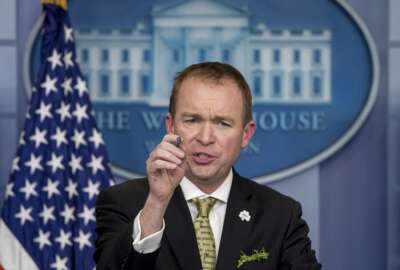The Office of Management and Budget’s new memo on reorganizing and restructuring makes clear what President Donald Trump has long suggested — that his administration can run the government more efficiently and effectively with a smaller federal workforce.
But OMB Director Mick Mulvaney said federal employees shouldn’t be depressed by the possibility of cuts. They should welcome the opportunity to create a more efficient and effective government — and get recognized for their good work, he said.
“One of the frustrations that government workers have is that we don’t reward those who do a really good job and we don’t punish those who do a lousy job,” Mulvaney said during an Apr. 11 briefing with reporters. “Imagine … working at an organization where you do a really nice job and you don’t get rewarded for it, you don’t even get acknowledged for that. What kind of morale would that create in that organization?”
But for many federal employees, this scenario might not be so difficult to imagine.
According to the results of the 2016 Federal Employee Viewpoint Survey, 29 percent of federal employees said their agencies effectively deal with poor performers who cannot or will not improve. About 34 percent said promotions within their agencies are based on merit, and 34 percent said differences in work are recognized in a meaningful way.
“That is one of the things we’ve asked agencies to look at,” Mulvaney said. “How do you restructure your personnel policies in order to point out people who are doing a great job, and figure out a way to get folks who are not delivering … to get them on board with whatever policy you’re trying to achieve?”
OMB’s memo does not detail specific agency reductions or cuts. But it describes how agencies should identify programs and personnel that are duplicative or non-essential — or whether they can merged with other functions or departments.
“It’s wrong to paint with a broad brush and say, because we are going to be reducing the overall size of government as part of this consistent with our budget, that that means that everybody should just focus on who’s getting fired,” Mulvaney said. “That’s the wrong message to take from this. The right message is, we’re trying to figure out a way to make the government more responsive and more accountable, and that means taking care of the people who are doing a good job.”
The memo strategically ties together three major White House initiatives: the President’s executive order calling on agencies to streamline and reorganize their functions and offices, his call to reduce the size of the federal workforce and the fiscal 2018 budget.
In a Federal News Radio survey, employees said talks of the coming budget cuts have put a damper on workforce morale, and most said they believe Congress will make good on the President’s proposed cuts to civilian agency budgets.
The budget calls for cuts to some agencies and boosts to others, and employees at those agencies may feel differently about their environment than workers at organizations that face significant reductions, said Margot Conrad, director of education and outreach at the Partnership for Public Service.
“A lot needs to be done to address employee morale,” she said. “[For] some agencies that may be more affected, employees there may be experiencing lower morale.”
Agency leaders should ask their employees for feedback as they draw up restructuring plans, Conrad said.
The memo also heavily focuses on poor performers and tasks agency leaders to develop plans to “maximize employee performance” by June 30.
OMB named five key areas that agencies should address in their performance management plans, including a review and update of formal poor performance policies, holding managers accountable for addressing employee performance and making performance improvement more transparent.
“When developed and executed in concert, these five actions and others agencies may identify will provide supervisors with the policies, processes and tools to be empowered and held accountable for managing employee performance such as by an improvement on the Federal Employee Viewpoint Survey (FEVS) questions on addressing employee performance,” the OMB memo said.
Yet both Conrad and Senior Executives Association President Bill Valdez said the memo focuses too much on poor performers and not enough on the high performers.
“Focusing on poor performers is only one half of the equation,” he said. “The real problem in the federal government isn’t necessarily poor performers, it’s how do you incentivize excellent performers. I would have liked to have seen more on that.”
As agencies examine personnel needs and costs, they may offer voluntary early retirement authorities (VERAs) or voluntary separation incentive payments (VSIPs) to reduce the size of the workforce, the memo said.
“You also need to look on the flip side and see what kind of incentives you can provide your employees, your top performers, to stay,” Conrad said. “Small incentives like that could go a long way.”
Mulvaney said the President is also sending a message by giving federal employees a 1.9 percent pay raise in 2018. It’s still unclear if the 1.9 percent will account for base pay and locality adjustments, but the President should give a clearer picture when he releases the full 2018 budget next month.
“These are people’s jobs and we get that,” Mulvaney said. “We recognize the fact that there will be people here looking at this going ‘oh my goodness, I work at an agency that may be downsized.’ That is real.”
“To the folks who do work here … if you’re a really good federal worker, you should welcome this, because now you’re finally going to get a chance to be rewarded for your contributions,” he added.
Copyright
© 2024 Federal News Network. All rights reserved. This website is not intended for users located within the European Economic Area.

